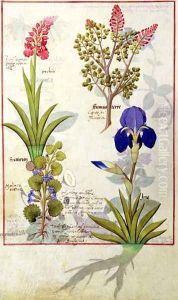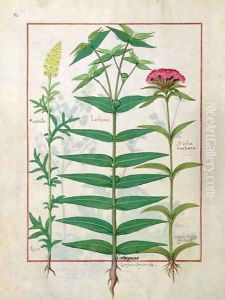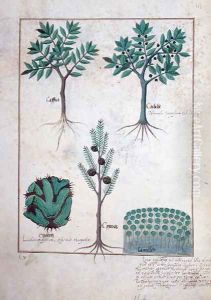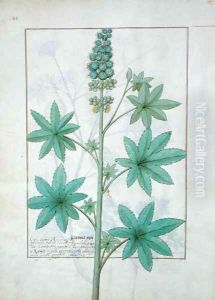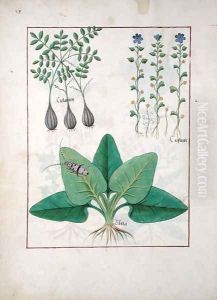





Chamomile (top left) and Cucumber (right) Illustration from The Book of Simple Medicines by Mattheaus Platearius d.c.1161 c.1470
-
About Reproduction
Discover the allure of art with our faithful reproduction of "Chamomile (top left) and Cucumber (right) Illustration from The Book of Simple Medicines by Mattheaus Platearius d.c.1161 c.1470", originally brought to life by the talented Robinet Testard. Unlike posters or prints, our hand-painted oil painting breathes an unique sense of depth and texture into your space. Every detail, every stroke, and every texture is meticulously recreated, paying the perfect homage to Robinet Testard and his artistic vision.
Owning this piece is more than just decoration - it's a statement of your refined taste in art. Let the vibrant colors and intricate details of this replica serve as a daily reminder of the beauty in our world. Elevate your decor and appreciate the richness of art with our replica of this masterpiece.
-
Painting Description
The illustration of Chamomile (top left) and Cucumber (right) from "The Book of Simple Medicines" by Mattheaus Platearius, dated circa 1161 and illustrated around 1470 by Robinet Testard, is a significant artifact in the history of botanical and medical literature. "The Book of Simple Medicines" (originally "Liber de Simplici Medicina" or "Circa Instans") is a medieval medical text that compiles knowledge about medicinal plants and their uses. Mattheaus Platearius, a physician from the renowned medical school of Salerno, authored this comprehensive guide, which became a cornerstone in the field of herbal medicine.
Robinet Testard, a French illuminator active during the late 15th century, is credited with illustrating this particular manuscript. His work is characterized by detailed and vibrant depictions of plants, which not only served an educational purpose but also enhanced the aesthetic value of the manuscript. The illustration of Chamomile and Cucumber exemplifies Testard's meticulous attention to botanical accuracy and artistic detail.
Chamomile, depicted in the top left of the illustration, has been historically valued for its calming and anti-inflammatory properties. It was commonly used to treat ailments such as digestive disorders, anxiety, and skin irritations. The plant is easily recognizable by its daisy-like flowers, which Testard has rendered with precision, capturing the delicate structure of the petals and the central disc florets.
Cucumber, shown on the right, is another plant with a long history of medicinal use. Known for its cooling and hydrating properties, cucumber was used to treat fevers, skin conditions, and to promote overall hydration. Testard's illustration captures the elongated shape and textured skin of the cucumber, providing a clear visual reference for identification.
This illustration not only reflects the medical knowledge of the time but also highlights the intersection of science and art in medieval manuscripts. The collaboration between Platearius' scholarly work and Testard's artistic skills resulted in a valuable resource for both contemporary and future generations, preserving the legacy of medieval herbal medicine.
-
Lead Time & Shipping
When you order this oil painting replica, it typically takes 2-3 weeks to paint. If the artwork is more complex, it might need a little more time to ensure the best quality. Once it's ready, we'll send you a photo for your approval. After you give the green light, we'll ship it to you for free.
-
Return & Refund
We believe in the quality of our hand-painted oil painting reproductions, and your satisfaction is our priority. If for any reason, you are not completely satisfied with your purchase, we offer a 45-day return policy. You can return your artwork within 45 days of receipt and receive a full refund. Please note that the artwork must be returned in the original packaging and in the same condition as it was received.







